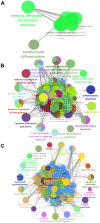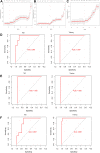Gene Set Index Based on Different Modules May Help Differentiate the Mechanisms of Alzheimer's Disease and Vascular Dementia
- PMID: 33737807
- PMCID: PMC7961151
- DOI: 10.2147/CIA.S297483
Gene Set Index Based on Different Modules May Help Differentiate the Mechanisms of Alzheimer's Disease and Vascular Dementia
Abstract
Purpose: Alzheimer's disease (AD) and vascular dementia shared similar symptoms, the aim of the present study was to identify potential differences in the mechanisms underlying the two diseases.
Materials and methods: The data set including AD, vascular dementia, and control samples was carried out gene differential expression analysis, weighted gene co-expression network analysis, functional enrichment, protein-protein interaction network construction, and least absolute shrinkage and selection operator analysis to reveal the differences in the mechanisms underlying the two diseases and potential diagnostic gene signature.
Results: We identified the gene modules related to AD or vascular dementia. Enrichment analysis of module genes and construction of a protein-protein interaction network suggested that the "brown" module may be involved in a chemokine pathway, the "blue" module may be involved in cortisol synthesis and secretion, and the "turquoise" module may be involved in cholinergic synapse transmission. The hub gene-based signature index may be a biomarker of AD and vascular dementia and may even differentiate the two diseases from each other with high area under curve.
Conclusion: Our results identified not only core pathways involved in both AD and vascular disease, but also their potentially specific pathways. We proposed the hub gene-based signature index may be useful for diagnosing AD and vascular dementia.
Keywords: Alzheimer’s disease; LASSO; WGCNA; vascular dementia; weighted gene co-expression network analysis.
© 2021 Zhou et al.
Conflict of interest statement
The authors declare that this research was conducted in the absence of any commercial or financial relationships that could be construed as a potential conflict of interest.
Figures








Similar articles
-
[Identification of potential hub genes of Alzheimer's disease by weighted gene co-expression network analysis].Nan Fang Yi Ke Da Xue Xue Bao. 2021 Dec 20;41(12):1752-1762. doi: 10.12122/j.issn.1673-4254.2021.12.01. Nan Fang Yi Ke Da Xue Xue Bao. 2021. PMID: 35012905 Free PMC article. Chinese.
-
Integrated Analysis of Weighted Gene Coexpression Network Analysis Identifying Six Genes as Novel Biomarkers for Alzheimer's Disease.Oxid Med Cell Longev. 2021 Jul 26;2021:9918498. doi: 10.1155/2021/9918498. eCollection 2021. Oxid Med Cell Longev. 2021. PMID: 34367470 Free PMC article.
-
Identification of Potential Therapeutic Targets of Alzheimer's Disease By Weighted Gene Co-Expression Network Analysis.Chin Med Sci J. 2020 Dec 31;35(4):330-341. doi: 10.24920/003695. Chin Med Sci J. 2020. PMID: 33413749
-
Phenotypic profiles and functional genomics in Alzheimer's disease and in dementia with a vascular component.Neurol Res. 2004 Jul;26(5):459-80. doi: 10.1179/016164104225017677. Neurol Res. 2004. PMID: 15265264 Review.
-
Recent advances in the genetics of Alzheimer's disease and vascular dementia with an emphasis on gene-environment interactions.J Am Geriatr Soc. 1996 Oct;44(10):1242-50. doi: 10.1111/j.1532-5415.1996.tb01377.x. J Am Geriatr Soc. 1996. PMID: 8856006 Review.
Cited by
-
Chemokines play a role in nerve damage and neuroprotection in vascular dementia.IBRO Neurosci Rep. 2024 Aug 5;17:154-160. doi: 10.1016/j.ibneur.2024.08.002. eCollection 2024 Dec. IBRO Neurosci Rep. 2024. PMID: 39206161 Free PMC article. Review.
-
Identification of Alzheimer's Disease Molecular Subtypes Based on Parallel Large-Scale Sequencing.Front Aging Neurosci. 2022 Apr 28;14:770136. doi: 10.3389/fnagi.2022.770136. eCollection 2022. Front Aging Neurosci. 2022. PMID: 35592696 Free PMC article.
-
REPS1 as a Potential Biomarker in Alzheimer's Disease and Vascular Dementia.Front Aging Neurosci. 2022 Jun 22;14:894824. doi: 10.3389/fnagi.2022.894824. eCollection 2022. Front Aging Neurosci. 2022. PMID: 35813961 Free PMC article.
-
Downregulation of miR-181c-5p in Alzheimer's disease weakens the response of microglia to Aβ phagocytosis.Sci Rep. 2024 May 20;14(1):11487. doi: 10.1038/s41598-024-62347-x. Sci Rep. 2024. PMID: 38769091 Free PMC article.
-
Identification of molecular signatures associated with sleep disorder and Alzheimer's disease.Front Psychiatry. 2022 Aug 4;13:925012. doi: 10.3389/fpsyt.2022.925012. eCollection 2022. Front Psychiatry. 2022. PMID: 35990086 Free PMC article.
References
-
- Jian C, Lu M, Zhang Z, et al. miR-34a knockout attenuates cognitive deficits in APP/PS1 mice through inhibition of the amyloidogenic processing of APP. Life Sci. 2017;182:104–111. - PubMed
MeSH terms
LinkOut - more resources
Full Text Sources
Other Literature Sources
Medical

